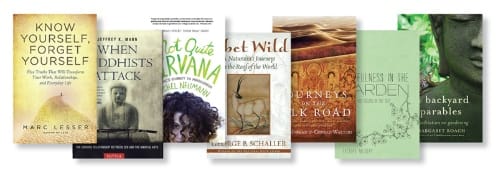KNOW YOURSELF, FORGET YOURSELF: Five Truths That Will Transform Your Work, Relationships, and Everyday Life
By Marc Lesser
New World Library 2013; 256 pp., $14.95 (paper)
As an executive coach, Marc Lesser helps clients make a shift in their immediate work issues. But in order to do that, he must transform their entire way of looking at themselves and the world.
The key to thriving in our work and lives, he says, is to embrace life’s paradoxes. After all, the way to find balance is to be open and responsive to imbalance—to be like a tightrope walker continually and instinctively feeling every wobble. According to Lesser, life’s paradoxes can be distilled into five core truths: know yourself, forget yourself; be confident, question everything; fight for change, accept what is; embrace emotion, embody equanimity; and benefit others, benefit yourself. This book is strongly rooted in Buddhist thought and practice. Lesser is a Zen teacher who lived at the San Francisco Zen Center for ten years and is a former director of the Tassajara Zen Mountain Center.
WHEN BUDDHISTS ATTACK: The Curious Relationship Between Zen and the Martial Arts
By Jeffrey K. Mann
Tuttle 2012; 224 pp., $16.95 (cloth)
The great Zen master Hakuin contended that a samurai could accomplish in a few days of Zen practice what would take a monk a hundred days. His reasoning was that monks generally assume they have years to devote to Zen, while warriors are well aware of impending death, so warriors will throw themselves into practice with a far greater sense of urgency than monks. That being said, the relationship between martial arts and Zen has been greatly exaggerated, especially in the West.
In When Buddhists Attack, Jeffrey K. Mann unpacks the facts and fiction. The fiction, he claims, begins right with Bodhidharma. As legend has it, this patriarch developed an exercise program for the monks at Shaolin Monastery who were struggling to endure his rigorous meditative practices, and these exercises eventually evolved into forms of staff fighting and unarmed combat. In reality, however, the most famous text attributed to Bodhidharma was penned a thousand years after his death, and scholars now doubt that he even set foot in Shaolin.
NOT QUITE NIRVANA: A Skeptic’s Journey to Mindfulness
By Rachel Neumann
Parallax Press 2012; 128 pp., $14.95 (paper)
Rachel Neumann has been Thich Nhat Hanh’s primary editor for ten years. When she first landed the job, she would read each page reverently and keep her editing ultra light. “I was like a housecleaner in a fancy home,” she writes, “tidying up here and there, perhaps washing out a particularly muddled paragraph or trimming the edges of a sentence, but certainly not rearranging the furniture.” Then one day she was simultaneously editing and nursing her new baby when she came across this line in a transcript: “When I was younger, I was a revolting monk.” Thich Nhat Hanh? Revolting? Thinking that was highly unlikely, Neumann changed the word to “rebellious,” and it was making that edit that gave her confidence to muscle around more with content and otherwise get her into her editing groove. Not Quite Nirvana is the engaging true story of Neumann learning mindfulness on the job and discovering how to apply it in her busy life with her family.
TIBET WILD: A Naturalist’s Journeys on the Roof of the World
By George B. Schaller
Island Press 2012; 374 pp., $29.95 (cloth)
Tibet Wild is a finely crafted memoir detailing George B. Schaller’s travels and conservation projects in the rugged Tibetan Plateau. (Schaller will be familiar to many readers as Peter Matthiessen’s expedition partner in his classic The Snow Leopard.) For thirty years, he has studied the region’s wildlife, including the rare Tibetan brown bear, the blue sheep, and the plateau pika, a small mammal that often is considered a pest (and is therefore poisoned), yet is key to maintaining the biological diversity of the region. Schaller’s driving passion, though, is for the chiru, or Tibetan antelope, and his studies have helped bring back its decimated population by drawing international attention to poaching. “Ultimately, the decision to save the environment must come from the human heart,” Schaller quotes the Dalai Lama as saying. Then Schaller himself adds: “The Buddhist religion stresses love and compassion toward all living beings, and this predisposes its followers to be receptive to an environmental message.”
JOURNEYS ON THE SILK ROAD: A Desert Explorer, Buddha’s Secret Library, and the Unearthing of the World’s Oldest Printed Book
By Joyce Morgan and Conrad Walters
Lyons Press 2012; 336 pp., $24.95 (cloth)
Journeys on the Silk Road tells the fascinating story of Aurel Stein, an archaeologist employed by the British government. His scholarship and explorations are at the root of almost everything that’s currently known about the Silk Road and Buddhism’s migration along it. While Stein died a hero in the West, in China he has long been reviled as a thief, and today many Westerners also see him in that light. In 1900, a Chinese monk named Wang Yuanlu discovered a hidden cave, unearthing scrolls piled from floor to ceiling that had been hidden for a thousand years. Among them was what is now recognized as the oldest dated printed book in the world: a complete copy of the Diamond Sutra. Printed on paper at a time when paper was unknown in the West, this scroll was produced 600 years before Gutenberg had even heard of ink. Stein bribed Wang with a mere four horseshoes of silver, then sneaked out of China, his caravan loaded down with loot from the caves.
MINDFULNESS IN THE GARDEN: Zen Tools for Digging in the Dirt
By Zachiah Murray
Parallax Press 2012; 160 pp., $16.95 (cloth)
THE BACKYARD PARABLES: A Meditation on Gardening
By Margaret Roach
Grand Central Publishing 2013; 288 pp., $25.99 (cloth)
Under the silvery-green-leafed olive trees in her yard, Zachiah Murray planted her first garden. She immediately fell in love with the scent and feel of the earth and with how gardening loosened the knot in her mind. Her love endured, and today Murray is a landscape architect and the author of Mindfulness in the Garden, a small, handsome book in which she offers gathas for gardeners. (A gatha is a short verse that we can recite as we do an action, which in turn helps us develop awareness of what we are doing.) For instance, for watering: “Don’t think you will die of thirst, dear soil. I bring to you the sky and the sea. I carry it to you in my hands, and together we shall drink.”
From Margaret Roach, the first garden editor of Martha Stewart Living, comes The Backyard Parables. It’s part memoir and part compendium of horticultural lore, and it even features a couple of recipes for garden-fresh veggies. “The garden is a perennial dharma talk—a meditation, a reminder to reflect,” writes Roach. “It teaches us to live with intimacy and attention, and asks that we feel the pulse of more than just our own interior life force, instead seeing ourselves as part of a vast, complex organism and story.”

